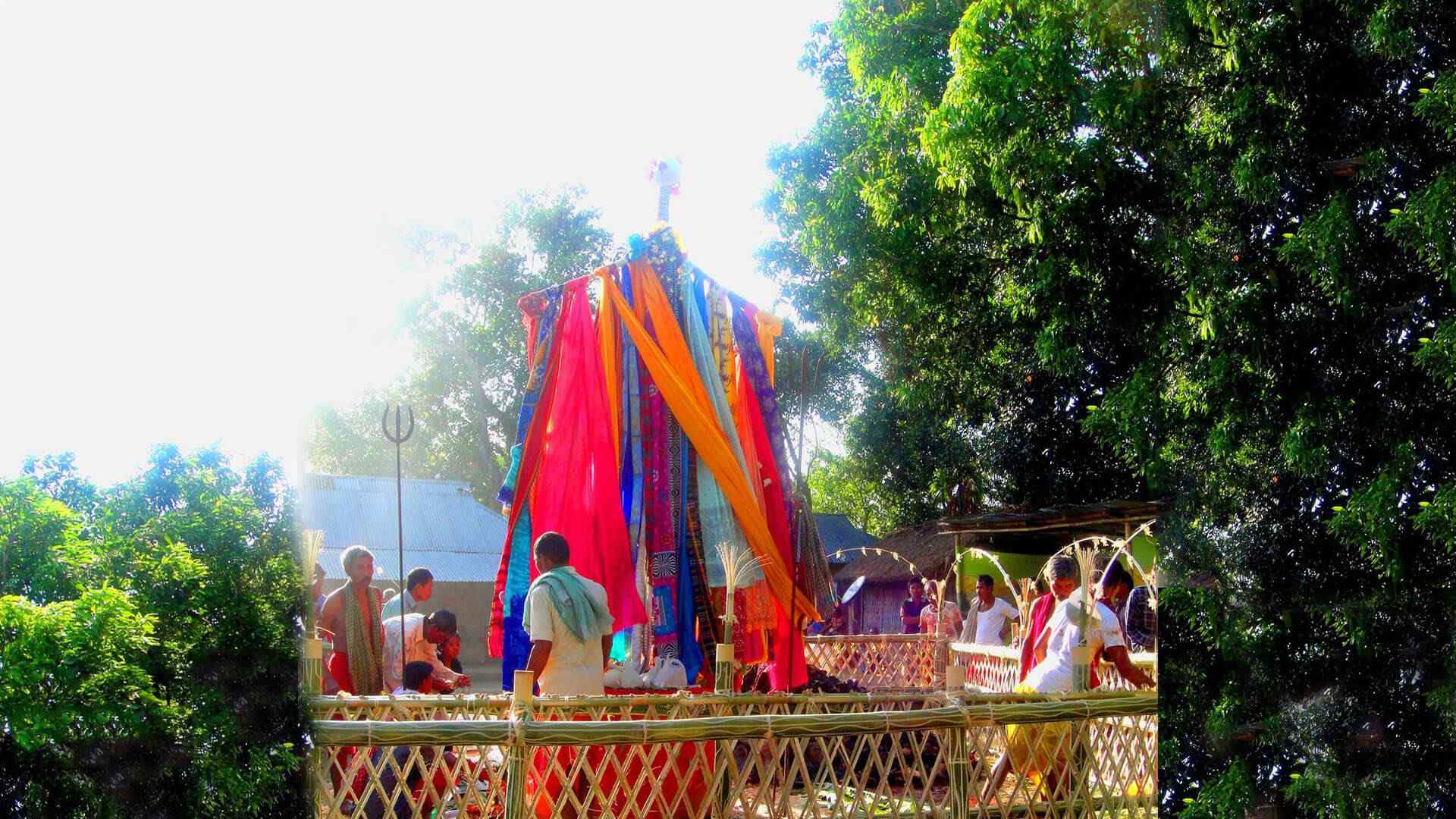
Every year in Tripura, the Garia Puja festival takes place, celebrating prosperity and livestock well-being. This week-long celebration includes traditional rituals, symbolic offerings, and a joyous spirit that brings the communities of Tripura together in reverence for Lord Garia, the deity of wealth and abundance.
CONTENT AVAILABLE AT THIS PAGE
History and Significance of Garia Puja
The Garia Puja festival takes place annually in Tripura, northeast India. It is a significant event that showcases the cultural traditions of the Tripuri people, combining religious rituals dedicated to Lord Garia with joyous celebrations.
The festival’s origins are unclear, with some believing it started from the rituals of the indigenous Tripuri tribal. It has evolved into a pan-Tripuri festival, celebrated by all communities in Tripura. This Puja is dedicated to Lord Garia, a deity who ensures the well-being of households, livestock, and prosperity. Devotees pray for good health, abundant harvests, and the thriving of their animals, essential to their agrarian lifestyle.
Symbolism is important in Garia Puja, where a decorated bamboo pole represents Lord Garia. Offerings like flowers, rice, and occasionally animal sacrifices show the connection between the Tripuri community and their land. The festival is lively, with traditional songs, dances, and fairs bringing communities together in a joyful atmosphere.
Garia Puja goes beyond being just a religious observance. It helps to build stronger social connections in Tripura, creating a sense of community and common goals. The festival is a time to appreciate nature’s blessings, show thanks for the abundance that supports life, and highlight the significance of livestock in Tripuri culture. This event offers insight into Tripura’s traditions, values, and lively essence, showcasing what makes this northeastern state special.
Preparations for Garia Puja
Before the This Puja festivities in Tripura, communities engage in thorough preparations to ensure a successful and joyous celebration:
- Purification and Cleansing: Homes undergo a thorough cleaning, symbolizing the purging of negativity and welcoming prosperity. Special attention is given to the puja space, ensuring a clean and serene environment for the rituals.
- Gathering of Offerings: Devotees meticulously gather the necessary offerings for Lord Garia. These often include rice, lentils, seasonal fruits and vegetables, flowers, and sometimes even sweets. In some communities, traditionally, specific types of cloth were offered, though this practice might be less common today.
- The Central Symbol: The Bamboo Pole: The most crucial element of preparation involves the creation of the decorated bamboo pole representing Lord Garia. This pole is carefully selected, ensuring its strength and straightness. Artistically skilled members of the community then embellish it with colorful fabrics, vibrant leaves, and sacred threads.
- Announcement and Invitation: As the day of the puja approaches, a sense of anticipation builds. Traditional drumbeats and chants, often accompanied by announcements, spread the word and invite the community to participate in the joyous celebrations.
The preparations for Garia Puja are essential for a successful celebration, bringing the community together in devotion and ensuring a prosperous year ahead while honoring Lord Garia.
Rituals and Traditions During Garia Puja
The celebration of This Puja involves meticulous planning and deep ritualistic practices. Weeks before the festivities, homes are cleaned thoroughly to rid them of negativity and prepare for blessings. Offerings like rice, lentils, fresh produce, and flowers are gathered to appease Lord Garia. A symbolic bamboo pole, representing the deity, must be carefully prepared with colorful fabrics, leaves, and sacred threads. The community eagerly anticipates the day, with traditional drumming and invitations spreading the excitement. These preparations are not just tasks but acts of devotion that unite the community and set the stage for a successful Garia Puja.
Garia Puja: The Biggest Festival in Madhya Pradesh
Garia Puja is an interesting festival with deep traditions, but it is not the largest celebration in Madhya Pradesh. Madhya Pradesh hosts festivals like Malwa Utsav and the Khajuraho Dance Festival which are vibrant and showcase art, music, and dance. Garia Puja is the main festival in Tripura, where it is a week-long tribute to Lord Garia, the protector of livestock and prosperity.
Importance of Garia Puja in the Community
The Garia Puja festival in Tripura is more than just a religious celebration; it is a vital part of the Tripuri community. Lasting a week, the festival goes beyond rituals to symbolize prosperity, gratitude, and community unity. Central to the festival is the reverence for Lord Garia, who protects households, livestock, and wealth. Offerings and rituals express thankfulness for the land’s abundance and the important role animals play in agriculture. The festival involves shared tasks and brings people together, strengthening social bonds and creating a sense of belonging. Garia Puja helps preserve cultural traditions and stories, ensuring they are passed down to future generations. Overall, it is a festive occasion to express gratitude, celebrate cultural identity, and seek blessings for a prosperous future.
Garia Puja: A Celebration for All
Garia Puja is more than just a Tripuri celebration, it welcomes all to join in. The festivities create an inclusive atmosphere and invite everyone to experience the unique culture of Tripura. The celebration is about gratitude for nature, seeking prosperity, and cherishing community. These themes resonate with people from all backgrounds. Garia Puja offers a glimpse into Tripura’s traditions and stories, showcasing its vibrant community. Ultimately, it is a celebration of life, hope, and togetherness that transcends cultural differences.
Conclusion:
Garia Puja is a week-long festival in Tripura that is filled with tradition, joyous celebrations, and a deep connection to the land. It involves religious rituals, offerings, bamboo poles, dances, and shared meals that strengthen social bonds and pass down cultural traditions. The festival showcases prosperity, gratitude, and community spirit, giving a glimpse into the values and vibrant spirit of Tripura.
Read Also: Is Gay Marriage Legal in India: Let’s Understand It
